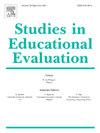Closing the gap through active learning variety and extent: A large-scale assessment of teaching clarity and course evaluation among students with learning disabilities
IF 2.6
2区 教育学
Q1 EDUCATION & EDUCATIONAL RESEARCH
引用次数: 0
Abstract
The growing population of students with learning disabilities in higher education necessitates a systematic evaluation of teaching methods. This study examines how the variety and extent of active in-class learning methods (small group work, independent work, student presentations, short quizzes) affect course evaluations and perceived teaching clarity among students with learning disabilities. Variety was measured by the number of methods used (0–4), and extent by their frequency during lessons. Analysis of 44,520 evaluation surveys reveals significant improvements in evaluation and teaching clarity as variety and extent increased. Moreover, the gap between students with and without learning disabilities nearly disappears with increased variety and extent: evaluation scores rose from 4.33 vs. 4.52 (minimal use) to 5.48 vs. 5.52 (extensive use). These findings highlight how variety and extent enhance teaching clarity, helping students compensate for learning disabilities. Along with smaller class sizes, they offer educators practical guidance for inclusive instructional design.
通过主动学习的多样性和程度缩小差距:对学习障碍学生的教学清晰度和课程评价的大规模评估
高等教育中学习障碍学生人数的不断增加,要求对教学方法进行系统的评估。本研究考察了课堂上主动学习方法(小组作业、独立作业、学生报告、简短测验)的多样性和程度如何影响学习障碍学生的课程评估和对教学清晰度的感知。多样性是通过使用方法的数量来衡量的(0-4),程度是通过在课程中使用方法的频率来衡量的。对44,520份评价调查的分析显示,随着种类和程度的增加,评价和教学清晰度有了显著提高。此外,随着种类和程度的增加,有学习障碍的学生和没有学习障碍的学生之间的差距几乎消失:评估分数从4.33比4.52(最小使用)上升到5.48比5.52(广泛使用)。这些发现强调了多样性和广度如何提高教学清晰度,帮助学生弥补学习障碍。随着班级规模的缩小,它们为教育工作者提供了包容性教学设计的实用指导。
本文章由计算机程序翻译,如有差异,请以英文原文为准。
求助全文
约1分钟内获得全文
求助全文
来源期刊

Studies in Educational Evaluation
Multiple-
CiteScore
6.90
自引率
6.50%
发文量
90
审稿时长
62 days
期刊介绍:
Studies in Educational Evaluation publishes original reports of evaluation studies. Four types of articles are published by the journal: (a) Empirical evaluation studies representing evaluation practice in educational systems around the world; (b) Theoretical reflections and empirical studies related to issues involved in the evaluation of educational programs, educational institutions, educational personnel and student assessment; (c) Articles summarizing the state-of-the-art concerning specific topics in evaluation in general or in a particular country or group of countries; (d) Book reviews and brief abstracts of evaluation studies.
 求助内容:
求助内容: 应助结果提醒方式:
应助结果提醒方式:


